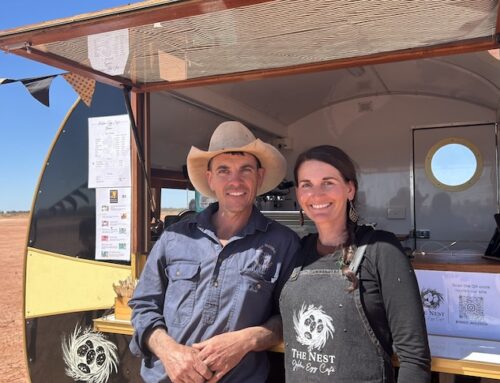Auroras, lightning sprites, satellite trains, the breathtaking Milky Way — the night sky is full of incredible things to see.
Many of us “make a wish on a shooting star”, set an alarm to catch a meteor shower, or get together to watch a lunar eclipse turn the Moon blood red.
For National Science Week, we want to hear from you about the most amazing thing you’ve seen in the night sky.
In previous years, we’ve asked you about your favourite tree (well done, river red gum) and what animal call you love most (the magpie, of course).
We’ve compiled a list of objects, constellations and events you can vote for — and there’s an exciting twist this year: you can also add your own suggestion.
So take a moment, remember your experience and let us know what’s filled you with awe and wonder.
Aurora
Auroras are formed when the solar wind tangles with the Earth’s magnetic field, creating glorious night time colour shows in areas near the poles. They’re more common at solar “maximums” — which is why we’re seeing so many this year. They’re on the bucket list for most people so consider yourself lucky if you’ve seen one.
Comet
Comets grace our night skies as they pass Earth on their travels through the Solar System. Made up of rock, dust and ice they heat up, glow and melt as they get close to the Sun, creating a long tail behind them. Some of the more memorable ones have been Halley’s, McNaught’s, Shoemaker-Levy 9, 12P/Pons–Brooks.
Emu in the Sky
Dark areas in the Milky Way create the Emu in the Sky, seen here with it’s head at the top right (a dark cloud) and it’s long neck, body and long legs (formed from dust lanes across the Milky Way) trailing to the bottom left. Many Aboriginal communities tell the story of the Emu in the Sky.
International Space Station
Appearing like a rapidly moving extra-bright dot in the sky, the International Space Station zips along steadily without changing direction. It’s in low-Earth orbit, which means it’s a little over 400 kilometres above us. It takes just 92.9 minutes to orbit Earth, so there are regular opportunities to spot it.
Jupiter’s moons
Spotting Jupiter’s four Galilean moons requires a set of binoculars or telescope, but the gas giant’s satellites are so large they can even be seen in light-polluted skies. Seeing them this way is like walking in the steps of Galileo Galilei who first observed the moons Io, Europa, Ganymede, and Callisto in 1610.
Large and Small Magellanic Clouds
These “clouds” look like two smudges of fuzzy light in a dark star-lit sky and are some of the most distant objects we can observe with the naked eye. They’re also two of the closest galaxies to us, with the Large Magellanic Cloud just a teeny 160,000 light years away and the Small Magellanic Cloud around 200,000.
Lightning sprites
Lightning sprites often appear as clusters of red-orange flashes in the night sky. Although they can be triggered by lightning in thunderstorms, they’re actually at least 50 km above the level of clouds, in the mesosphere. These fleeting electrical discharges may appear small but can be about 50 km wide.
Lunar eclipse
Watching a lunar eclipse is a leisurely event as the Earth’s shadow moves slowly across the full Moon, gradually reducing the visible area. The Moon turns a blood red during “totality” when the Earth’s shadow completely covers it. The next total lunar eclipse we will see in Australia is September 7, 2025.
Mars
Mars appears as a bright red point of light in the night sky making it one of the easiest planets to spot (as well as one of the easiest to explore!). As a planet orbiting around the Sun, Mars changes its position in the night sky relatively quickly, compared to the backdrop of stars.
Meteor or shooting star
Catching a glimpse of a meteor or shooting star is pretty exciting, as they’re generally quick and unexpected events. They occur when space rocks (known as meteoroids) enter Earth’s atmosphere at high speed and burn up spectacularly before reaching the surface. This one was captured over Brisbane in 2024.
Meteor shower
Watching a meteor shower can be a spectacular and rewarding event with lots of shooting stars (meteors) over several hours. And as meteor showers are often predicted, it’s easy to plan to see them. They occur when Earth travels through streams of dust, grains and rock often left behind by passing comets.
The Milky Way
Many of us remember the first time we saw the awe-inspiring Milky Way. It’s best seen in remote or dark sky locations where it appears as a cloud sprawled across the starry sky. What we’re seeing is the galactic centre of the barred spiral Milky Way galaxy that we reside in, which contains maybe 100–400 billion stars.
The Moon
Watching the full Moon rise is an amazing experience that repeats every month, but the Moon also looks beautiful as it waxes and wanes from full to crescent to new moon. As Earth’s only natural satellite, the Moon has enormous cultural and environmental importance. And it creates the tides.
Moon halo
Appearing as an ethereal ring surrounding the Moon, a lunar halo (or moon bow, storm ring) forms when tiny ice crystals in the atmosphere refract the moonlight, creating a circle. Moon halos were used in traditional Aboriginal and Torres Strait Islander culture as weather predictors.
Orion Nebula
This beautiful nebula can be seen in the constellation Orion, which is often called “The Saucepan” in Australia. The Orion Nebula appears as a fuzzy star in the handle of the saucepan (or Orion’s sword). With binoculars you can see a lot more detail, although you’ll need a telescope to get this view.
Planetary conjunction
These occur when planets appear close to each other in the sky, when observed from Earth. In reality, these planets are still very far away from each other. Only two planets are required for an alignment, but in June this year there was a rare alignment of Jupiter, Mercury, Uranus, Mars, Neptune and Saturn.
Pleiades
Also known as the Seven Sisters in Aboriginal (and other) cultures, the Pleiades appear as a bright misty cluster of stars. It’s generally possible to spot at least six of the sisters (stars) with the naked eye. The stars in the Pleiades are actually sisters, having been born from the same cloud of gas and dust.
Saturn’s rings
Saturn appears as a bright star in the night sky, but when you take a look through a telescope it’s incredibly exciting when the planet’s beautiful rings come into view. And while these rings are enormous, they’re shockingly thin, with a depth of only 100 metres. They’re made up of small chunks of ice, rock and dust.
Stargazing in a dark sky location
With zero light pollution, stargazing in a dark sky location gives the most overwhelming view of the night sky: thick with stars and the best possible view of the Milky Way, planets and distant galaxies. There are many dark sky locations in Australia, generally inland and in remote areas.
Starlink train
Spotting a megaconstellation of satellites — a Starlink train — can be deeply shocking as they look somewhat unnatural or alien in the night sky. If you haven’t yet seen one, your chances are ever-increasing as more and more satellites are being launched, with numbers set to climb dramatically in the near future.
Supernova 1987a
You’d be extremely lucky to have seen this one in real life, but for those who did, it was a memorable event. Visible only in the southern hemisphere, a bright supernova explosion in the Large Magellanic Cloud was noticed in February 1987. For a short time it could be seen with the naked eye.
Venus
Venus is the brightest object in our night sky, apart from the Moon, and it’s orbit brings it closer to Earth than any other planet. Its bright appearance in the morning and evening skies is why it’s called both the Morning Star and Evening Star in many cultures. It’s similar in size to Earth, but spins in the opposite direction.
In this first round of voting you can choose up to three awe-inspiring things — an event, object or constellation that has amazed you when you’ve seen it in the night sky. You can also suggest something we’ve missed.
Then on Monday August 12, the voting will start again with the top 10 night sky experiences, based on all your votes and suggestions.
And we’ll reveal Australia’s most beloved thing in the night sky in a live blog on Friday August 16. We will also answer your questions about light pollution and the dark night sky — and share the results of the Australian National University Milky Way survey.
Stay up-to-date with our search for the most amazing thing Australians have seen in the night sky by signing up to our weekly newsletter.
Aurora (Arwen Dyer); Comet(Getty Images: John White); Emu in the sky (Supplied: James Garlick); International Space Station (Supplied: Dennis Mellican); Jupiter’s moons (Wikimedia Commons/Freak-Line Community/CC BY-SA 4.0); Small and large Magellanic clouds.(Getty Images: MXW Photo); Lightning sprites (Supplied: Ben Broady Photography); Lunar eclipse (Adam Morrissey: User submitted); Mars (Wikimedia: cafuego/CC BY 2.0); Meteor (Supplied: Dennis Mellican); Meteor shower (Getty Images: Shao Miao); The Milky Way (ABC Open: Kartikeya1986); The Moon (Getty Images: James Yu); Moon halo(Getty Images: Jason Whittle XS Light); Orion Nebula (Flickr: Giuseppe Donatiello, Orion Nebula CDK24, Public domain); Planetary conjunction (Getty Images: Brad McGinley Photography); Pleiades (Supplied: ESO/S. Brunier); Saturn’s rings (Supplied: Dennis Mellican); Stargazing in a dark location (Flickr: Scott Cresswell); Starlink train (Reddit: u/rdub001); Supernova 1987a (Supplied: NASA); Venus (Flickr: Venus and shearing shed/Indigo Skies Photography/CC BY-SA 2.0).



